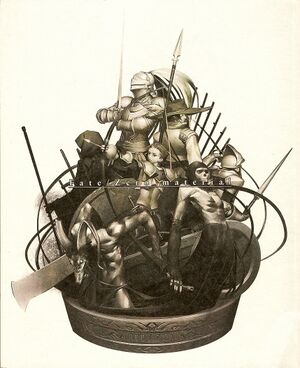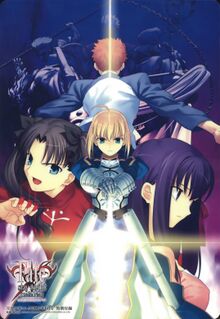Nasuverse

The Nasuverse is a fictional universe created by Japanese author Kinoko Nasu. His partner in crime for most of this is Takeuchi Takashi. Together the two of them form media company Type-Moon, license-holder for that which follows and ruler of all waifus.
The Nasuverse is basically an urban fantasy setting. Mages, vampires, zombies, and the Holy Grail are all real. Mages spend most of their time fighting each other over petty arguments, circlejerking in the magic academy inside of Big Ben, and committing crimes against humanity in the name of progressing their research. They only stop once in a while to fight over the Holy Grail so they can gain complete knowledge of the universe and access to the Akasha, or whatever.
Overall, the Nasuverse is pretty much the intersection of /a/, /v/, and /tg/, and it's been around long enough that there's something for everyone. Nasu himself is a fan of Dungeons and Dragons and plays it a lot. Enough that he and a bunch of other weeaboo authors got together and recorded some of their play sessions in that weird Japanese tradition of replay books. It's called Red Dragon, and the anime about it sucks, so if you're that much of a weeaboo you should just read the source material.
Kara no Kyoukai
Kara no Kyoukai is the oldest entry in what would become the Nasuverse. The first chapters were published way back in 1998, so they're probably older than the people reading this right now. It's so old that most people know about it from the series of seven movies by Ufotable.
The main character is Ryougi Shiki, and she has the Mystic Eyes of Death Perception. Yes, death, not depth. These are a form of magic vision that let her see the "implicit death" in all things. In less idiotically obtuse terms, she can see the lines of weakness in anything, and if she cuts them, that thing is destroyed beyond repair.
Anyone who calls it "The Garden of Sinners" is probably a fag.
Tsukihime
Tsukihime is a visual novel that's one part murder mystery, one part dating simulator, and one part gothic horror. Its main character, Tohno Shiki, survives a car crash as a child and is disowned by his wealthy parents for his frail constitution. What he gains are the Mystic Eyes of Death Perception introduced in Kara no Kyoukai, enabling him to cut through anything. The story begins when he's called back to his family manor upon the death of the family patriarch. This gets him embroiled in the grisly 'vampire murders' occurring throughout town, which the various routes of the story either explore or ignore entirely.
The five choices of waifu, and therefore of routes in the story, are:
- Arcueid Brunestud, vampire-hunting vampire and True Ancestor
- Ciel, ninja-nun and vampire hunter working for the church
- Tohno Akiha, Shiki's older sister and heiress to the Tohno family fortune. She's used to acting the part of a financial conglomerate heiress.
- Hisui, Maid One of the pair remaining at the Tohno family mansion. She's quiet and keeps things formal.
- Kohaku, Maid Two at the Tohno mansion. She's the cheery big sister type to contrast Hisui's cool exterior.
Other waifus featured are Aozaki Aoko, a mentor figure Shiki met when he was still recovering from his accident, and Yumidzuka Satsuki, the designated classmate love interest. They don't get routes, so they don't count.
If you're poor and like fighting games, the spinoff Melty Blood is pretty popular for having a pirate version with better netplay than the official release. At least enjoy the music.
"Can Shiki kill Servants" is one of the fastest ways to start fights among Nasuverse geeks, and any relevant discussion quickly devolves into a total clownshow of powerlevel arguments.
Fate
Fate is the biggest part of the Nasuverse and the one most people know. It started as a visual novel all the way back into 2004, and has since ballooned out into a money-printing machine with an uncountable number of spinoff series. Entries in the Fate series are distinguished from one another by the text after the slash (/). You have Fate/Stay Night, Fate/Zero, Fate/Extra, Fate/Hollow Ataraxia... and most infamously, Fate/Grand Order. So no, it's not Fate Stay/Night. The series is called Fate.
The big thrust of the Fate series is the Holy Grail War, in which seven mages get together in a not-that-big city in Japan and summon legendary heroes as their bodyguards and warriors. All of them duke it out for the right to touch the Holy Grail. Last man standing gets to wish for whatever they want. The whole thing was put together a couple hundred years ago by three of the great mage families in an effort to reach the deepest truth of the universe, known as the Root. The War part got involved when they got close and all started fighting to be the ones who actually got to see it.
A total of seven mages are selected to fight in the Grail War. Each one summons one hero, known as a Servant, and acts as their Master. It's the Master's job to strategize during the war, and the Servant's job to actually engage in combat. All Masters are given a set of three Command Spells on their arm that mark them as Masters, allowing them to give three absolute orders to their Servant. Each of the Servants belongs to one of the seven classes:

- Saber, for swordsmen. "Saber" is a class and not a weapon because Nasu probably did an Engrish and thought the -er ending meant it was a name for someone trained in swordplay the same way archer is a name for someone who does archery.
- Archer, the biggest meme of a class. The Archer from the first entry in the series spends most of his fights dual-wielding swords, and the Archer in the prequel doesn't even use a bow, preferring to fire swords as projectiles.
- Lancer, a class for fast guys with long poking sticks. Lancers are commonly drawn from Gaelic myth. Their being Irish is something fans take the piss out of really often, because most of them have absolutely horrible luck.
- Rider, for pretty much anyone who's associated with a vehicle. World-conquering leaders, famous pirates... Even being an infamous slut is enough to qualify a hero for this class.
- Caster, for anyone actually good at magic. Alchemists and writers get to come too.
- Assassin, for the most legendarily dick-assed of dick-ass thieves. Per the "rules" of the Grail War, an Assassin-class Servant is always one of the leaders of Hashshashins, all of whom took the name Hassan-i Sabbah. Because this is anime, rules don't count, and this one gets broken pretty much all the time.
- Berserker, a class for heroes with varying levels of RAGE. Berserkers range from incoherent roaring monster-men to "coherent every now and then," quantified by their Mad Enhancement rating. High Mad Enhancement strengthens them more, but makes them more difficult to control and harder to understand.
Every Servant gets a Noble Phantasm Revealing your Servant's Noble Phantasm is pretty much a dead giveaway as to their identity, because by definition an NP is something that most defined the Servant when they were alive. Most Masters keep this close to their chest for as long as they can, because all of a Servant's weaknesses from their old legend still apply.
This series is the most directly /tg/, since Servants are traditionally given character sheets with ability scores, skills, and even alignments. They don't play by the rules (one Berserker has the alignment Lawful Mad), but it's fun to speculate about what kind of abilities these actually correspond to.
Fate/Stay Night

Fate/Stay Night was the original work in the Fate series, released as a visual novel in 2004. It's where you get ancient memes like "People die when they are killed," and "I am the bone of my sword." The Holy Grail War depicted in F/SN is the Fifth Grail War, and it features the following heroes:
- Saber - King Arthur, but a girl. Her Noble Phantasm is Excalibur.
- Archer - [REDACTED]. Archer actually isn't a legendary hero at all. At least, he's not a legend in the time Fate/Stay Night takes place.
- Lancer - Cu Chulainn. His Noble Phantasm is the spear
Gay BulgeGae Bolg. The one who began the trend of Lancer's having E-Rank Luck. - Rider - Medusa. Why? Because Pegasus was born when she was decapitated, so she gets to use it as her Noble Phantasm even if she isn't Perseus.
- Caster - Medea. She's still bitter about Jason cucking her, so she maintains a sadistic streak. Her Noble Phantasm lets her sever magical contracts, which gets real intriguing when you remember that those are what bind Servants to Masters.
- Assassin - Sasaki Koijrou, autistic samurai. Trained so hard with his weeaboo stick that he developed the ability to make three sword slices simultaneously, but that's not an "implement" so he doesn't get a Noble Phantasm.
- Berserker - Herakles. He's too angry to use a weapon well enough to bring out its potential as a Noble Phantasm, so instead he gets extra lives. You heard that right.
Yes, that girl with the platemail-dress combo is King Arthur. This introduced huge amounts of butthurt, and anyone not willing to tolerate waifu bullshit usually gets turned off of the series at this point. The origin of this affront to historical veracity has to do with F/SN's origins as a visual novel, which in Japan are only purchased by geeks with PCs looking to whack off. Nasu's original plan was actually to have the main character be a girl and keep King Arthur as an actual king, but his artist and comrade Takeuchi convinced him they would do much better in the VN market if the protagonist was a male the audience could project on, and King Arthur was a girl. So history was made.
All that aside, the actual plot of Fate/Stay Night follows Emiya Shirou, a boy who was adopted by Emiya Kiritsugu when the fallout from the Fourth Grail War turned Shirou's neighborhood into a burning hellscape. Ten years later, he gets wrapped up in the aforementioned Fifth Grail War when he unwittingly summons Saber.
Fate/Zero

Fate/Zero is the prequel to Fate/Stay Night dedicated to exploring the backstory of Shirou's adoptive dad Kiritsugu. Originally released as a light novel in 2006, it got an anime in 2011. This was the first serious work at adapting Fate to anime since the disastrous 2004 adaptation of Fate/Stay Night. This has earned a position of major skubbery among Fate fans, since it brought in huge numbers of newfags. This entry in the Nasuverse tends to start arguments about what amount of edge is acceptable in the Nasuverse and whether or not Fate/Zero has too much of it. This owes to Zero's actual writing being done not by Nasu, but by Gen "The Urobutcher" Urobuchi. Yes, the Madoka guy. The one infamous for killing characters to generate easy drama because he can't figure out any other way to move the plot forward. Zero is still like that.
Anyway, Zero is about the Grail War that Kiritsugu participated in and that ended up with him adopting Shirou. Kiritsugu is a hardass who doesn't play by hoity-toity mage rules. Of the seven mages fighting in the Grail War, he's the only one using guns, and spends most of the time with his servant on the Sidelines while he handles things with firepower. He's pretty much playing Shadowrun while the rest of them are pretending to be Harry Potter villains.
Zero's cast of Servants is as follows:
- Saber - King Arthur. This is where we first hear of her as the "King of Knights." A lot of her relationship with Kiritsugu is post-facto foreshadowing and ironic reversals of her relationship with Shirou in Stay Night.
- Archer - Gilgamesh. As pretty much the first hero ever recorded, he's "King of Heroes." His Noble Phantasm is the Gate of Babylon, which lets him pull any kind of weapon he wants out of the ether. He's the original hero, so of course all other legends are derived from him, which means he has the original versions. Basically, he cheats. He's too arrogant to swordfight with these treasures, so he earns Archer status by launching them at his enemies.
- Lancer - Diarmuid ua Duibhne. If you thought Cu got it bad in Stay Night, very few suffer more than ol' Deermud.
- Rider - Alexander the Great. Summoned as he was at the height of his empire, he's known by the name the Persians gave him, Iskandar. He rounds out the three kings in Zero as "King of Conquerors."
- Caster - Gilles de Rais. The famous murder-rapist of children maintains his fetish for Joan of Arc. When he crosses paths with Saber, he mistakes her for his beloved Jeanne. He gets command of lots of tentacles via the actual Necronomicon and continues to spend most of his time murdering children.
- Assassin - Hassan of the Many Faces. Instead of one assassin, this Servant gives the Master access to a whole mess of Assassins that lack the superhuman abilities of a Servant. Their disposability makes them useful as scouts.
- Berserker - Lancelot. He spends most of the series incognito, only revealing his identity for a final duel against Saber. Notable for using his Noble Phantasm to hijack an F-15 fighter jet, dogfight with it against Gilgamesh, then turn it against Saber.
Other Works
Mahoyo
"Witch on the Holy Night," abbreviated Mahoyo from the Japanese Mahoutsukai no Yoru, is one of the last visual novels written by Nasu and drawn by Takeuchi. It follows Aozaki Aoko and her time as a magician before her run-in with Shiki in Tsukihime. It's infamous in English-speaking weeaboo circles for never ever getting translated -- even though the French already have a fan translation done.
Carnival Phantasm
Carnival Phantasm is the obligatory comedy cross-over that all long-running Japanese series have to do at least once. It is very silly.